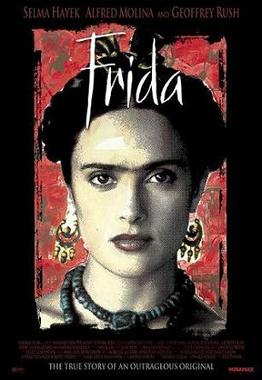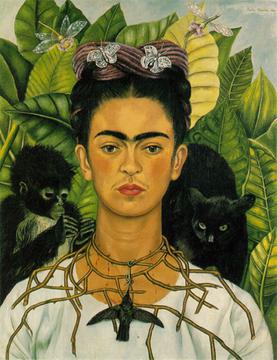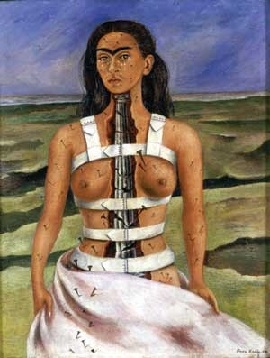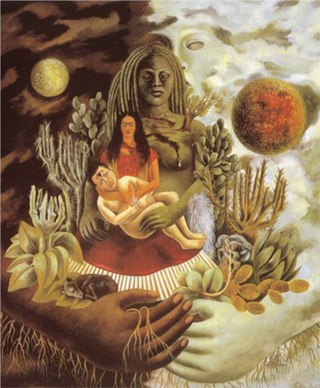
Magdalena Carmen Frida Kahlo y Calderón was a Mexican painter known for her many portraits, self-portraits, and works inspired by the nature and artifacts of Mexico. Inspired by the country's popular culture, she employed a naïve folk art style to explore questions of identity, postcolonialism, gender, class, and race in Mexican society. Her paintings often had strong autobiographical elements and mixed realism with fantasy. In addition to belonging to the post-revolutionary Mexicayotl movement, which sought to define a Mexican identity, Kahlo has been described as a surrealist or magical realist. She is also known for painting about her experience of chronic pain.

Frida is a 2002 American biographical drama film directed by Julie Taymor which depicts the professional and private life of the surrealist Mexican artist Frida Kahlo.
Malka Drucker is an American rabbi and author living in Santa Barbara, California.

Alice Phillipot (Alice Rahon) (8 June 1904 – September 1987) was a French-born Mexican poet and artist whose work contributed to the beginning of abstract expression in Mexico. She began as a surrealist poet in Europe but began painting in Mexico. She was a prolific artist from the late 1940s to the 1960s, exhibiting frequently in Mexico and the United States, with a wide circle of friends in these two countries. Her work remained tied to surrealism but was also innovative, including abstract elements and the use of techniques such as sgraffito and the use of sand for texture. She became isolated in her later life due to health issues.

The Frida Kahlo Museum, also known as the Blue House for the structure's cobalt-blue walls, is a historic house museum and art museum dedicated to the life and work of Mexican artist Frida Kahlo. It is in the Colonia del Carmen neighborhood of Coyoacán in Mexico City. The building was Kahlo's birthplace, the home where she grew up, lived with her husband Diego Rivera for a number of years, and where she later died in a room on the upper floor. In 1957, Rivera donated the home and its contents to turn it into a museum in Kahlo's honor.

Self-Portrait with Monkey is an oil on masonite painting by Mexican artist Frida Kahlo, commissioned in 1938 by A. Conger Goodyear, then president of the Museum of Modern Art in New York City. It is one of the many self-portraits painted by Kahlo for friends and patrons during her career.

The Two Fridas is an oil painting by Mexican artist Frida Kahlo. The painting was the first large-scale work done by Kahlo and is considered one of her most notable paintings. It is a double self-portrait, depicting two versions of Kahlo seated together. One is wearing a white European style Victorian dress, while the other is wearing a traditional Tehuana dress. The painting is housed at the Museo de Arte Moderno in Mexico City.

What the Water Gave Me is an oil painting by Frida Kahlo that was completed in 1938. It is sometimes referred to as What I Saw in the Water.

The Wounded Table is an oil painting by Mexican artist Frida Kahlo. Although lost in 1955, three photos of this painting were taken between 1940 and 1944. The painting was first displayed in January 1940 at the International Surrealism Exhibit at Inés Amor's Gallery of Mexican Art in Mexico City, and a replica is currently displayed in the Kunstmuseum Gehrke-Remund, Baden-Baden, Germany. The painting was last exhibited in Warsaw in 1955, after which it disappeared, and is the subject of an ongoing international search.

Self-Portrait with Thorn Necklace and Hummingbird is a 1940 self-portrait by Mexican painter Frida Kahlo which also includes a black cat, a monkey, and two dragonflies. It was painted after Kahlo's divorce from Diego Rivera and the end of her affair with photographer Nickolas Muray.

The Broken Column is an oil on masonite painting by Mexican artist Frida Kahlo, painted in 1944 shortly after she had spinal surgery to correct on-going problems which had resulted from a serious traffic accident when she was 18 years old. The original is housed at the Museo Dolores Olmedo in Xochimilco, Mexico City, Mexico.

The Love Embrace of the Universe, the Earth (Mexico), Myself, Diego, and Señor Xolotl is a 1949 painting by Frida Kahlo. Created in Mexico, the 70 cm x 60.5 cm painting was painted with oil on Masonite. It was featured on the reverse of the Series F $500 peso banknote, issued in 2010.

Cristina Kahlo y Calderón was the sister of artist Frida Kahlo. Frida painted a portrait of Cristina, titled Portrait of Cristina, My Sister, and Diego Rivera, Frida's husband, also portrayed Cristina Kahlo in his work. Cristina, with whom Rivera had an affair, was painted by Rivera in the nude.

Frieda and Diego Rivera is a 1931 oil painting by Mexican artist Frida Kahlo. This portrait was created two years after Frida Kahlo and Diego Rivera married, and is widely considered a wedding portrait.

The Frame is a 1938 self-portrait by Frida Kahlo. The painting features Kahlo's self-portrait in oil on a sheet of aluminum framed in glass which she purchased from a market in Oaxaca, Mexico. Although the glass frame is included as part of the painting, the flowers, birds, and other details on the frame were painted prior to being purchased by Kahlo.

Memory, the Heart, a 1937 painting by the Mexican artist Frida Kahlo, depicts the pain and anguish Kahlo experienced during and after an affair between her husband, artist Diego Rivera, and her sister, Cristina Kahlo.

Self Portrait with Loose Hair, also known as Self Portrait with Unbound Hair, is a 1947 oil-on-masonite painting by Mexican artist Frida Kahlo.

Self-Portrait Dedicated to Leon Trotsky, also known as Between the Curtains, is a 1937 painting by Mexican artist Frida Kahlo, given to Leon Trotsky on his birthday and the 20th anniversary of the October Revolution. Kahlo and her husband, artist Diego Rivera, had convinced government officials to allow Trotsky and his second wife, Natalia Sedova, to live in exile in Mexico. The Russian couple moved into the Blue House (La Casa Azul), where they resided for two years.

Self-portrait in a Velvet Dress is a 1926 oil-on-canvas painting by Mexican artist Frida Kahlo.

Frida is a 2024 documentary film directed by Carla Gutierrez about the life of Mexican painter Frida Kahlo. As Gutierrez's directorial debut, it was first shown at the 2024 Sundance Film Festival where it won the U.S. Documentary Jonathan Oppenheim Editing Award.



















